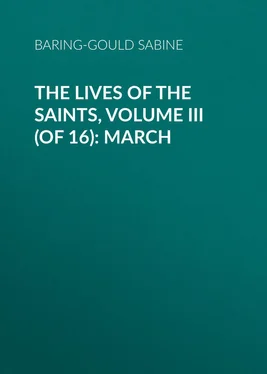He is called Guennole, or Vignevale, in French. At Montreuil-sur-Mer, of which place he is patron, he is called S. Valois. His name has also been corrupted into Valvais and Vennole.
The best account of the Manichæan tenets of the medæval heretics is in Hahn: Geschichte der Ketzer, vol. i.; the texts are given in notes, upon which he bases his opinion. See also Gieseler's Ecclesiastical Hist., 3rd division, chap. vii.; but Gieseler is less full and impartial than Hahn.
"Hæreticus ponit duo principia, diabolum dicens creatorem omnium visibilium." Pet. Vallium Sarnaii, apud Bouquet xix. p. 5. Reiner in Max. Bibl. xxv. p. 263. "Quorum finis est Manichæorum induere sectam et duos fateri Deos, quorum malignus, ut procaciter mentiuntur, creavit omnia visibilia." – Lucas Tudens. xvi., p. 240.
"Sathanam magnum Luciferum qui propter elevationem et nequitiam suam de throno bonorum cecidit angelorum, creatorem cœli et terræ, omniumque rerum visibilium et invisiblium, spirituum malorum creatorem et principem et Deum esse profitebantur ipsumque legem Moysi dedisse asseverant." – Chron. Gonfredi in Bouquet xii., p. 448.
"Erant alii hæretici qui dicebant quod unus est Creator; sed habuit filios, Christum et diabolum." Petr. Vall. Sarn. apud Bouquet xix. p. 5.
Petr. Vall. Sarn. ib., c. 2.
Ibid., p. 5.
Arch. Inquisit. Carcass. in Vaissette iii., p. 435.
"Dicebant in secreto suo, quod Christus ille qui natus est in Bethleem, terrestori et visibili, et in Hierusalem crucifixus, malus fuit; et quod Maria Magdalena fuit ejus concubina, et ipsa fuit muiler in adulterio deprehensa, de qua legitur in Evangelio. Bonus enim Christus … nunquam comedit vel bibit, nec veram carnem assumpsit, nec unquam fuit in hoc mundo nisi spiritualiter in corpore Pauli." Petr. Vall. Sarn. apud Bouquet xix. p. 5 "Quod Dei filius non assumpsit in beata et de beata Virgine carnem veram, sed fantasticam." Reg. Inquisit. Carcass. apud Vaissette ii. p. 372.
Petr. Vall. Sarn. ib. xix. p. 5; Reiner, in Mar. Bibl. xxv. p. 263; Lucas Tudens. ib. p. 241; Acta Conc. Lumbar. Bouquet xiv. p. 438.
Petr. Vall. Sarn. ib. p. 5, 6. "Dicunt quod anima hominis non est nisi purus sanguis," Reg. Inq. Carcass. Vaissette p. 327.
Lucas Tud. in Max. Bibl. xxv. De altera vita, p. 193-212.
Reiner, in Max. Bibl. xxv. p. 263. Petr. Vall. Sarn. apud Bouquet xix. p. 5, etc. "Sacrum matrimonium meretricium esse, nec aliquem in ipso salvari posse prædicabant, filios et filias generando."
"Dicunt quod simplex fornicatio non est peccatum aliquod." Reg. Inq. Carcass. Vaissette iii. p. 371.
Historia Inquisitionis, Amst. 1692, c. 8.
A large number of the sentences – all the most important – are translated and published in Maitland's Tracts and Documents, together with many of the letters, bulls, edicts, and controversial writings on the Albigenses.
Foulques was famous as a troubadour for his licentious poetry. His biography is given December 25: by an irony of fate, the commemoration of this firebrand is on Christmas Day, when "Peace on earth" was sung by angels.
See Dr. Lanigan's Irish Eccl. Hist. ii. p. 483-6.
Jacques II. of Bourbon, Count of la Marche and de Castres, married to Jeanne Q. of Naples and Sicily, was imprisoned by his wife, but escaped, and becoming a third Order brother of S. Francis, at Besancon, died there, Sept. 24, 1428.
These stocks, called Nervus, were a wooden machine with many holes, in which the prisoners' feet were fastened and stretched to great distances, as to the fourth or fifth holes, for the increase of their torments. S. Perpetua remarks, they were chained, and also set in this engine during their stay in the camp-prison, which seems to have been several days, in expectation of the day of the public shows.
It is evident from the visions S. Perpetua had of her little brother, that the Church, at that early age, believed the doctrine of Purgatory, and prayed for the faithful departed.
Pro ordine venatorum. Venatores is the name given to those that were armed to encounter the beasts, who put themselves in ranks, with whips in their hands, and each of them gave a lash to the Bestiarii, or those condemned to the beasts, whom they obliged to pass naked before them in the middle of the pit or arena.
Does not this remind the classic scholar of the description of the death of Polyxena, by Talthybius, in the Hecuba, "She even in death showed much care to fall decently."
Such is the legend, but possibly it may have been coined after the death of S. Thomas.












